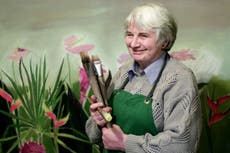Paula Rego: Artist who used her work to explore being a woman
The British-Portuguese painter sought to challenge the structures of power and authority that affect women’s lives

Paula Rego, who has died aged 87, was the uncompromising artist who helped to change the way in which women were represented in painting, printmaking and sculpture.
“The way Rego approaches the exploration of women has nothing to do with a performance or a stereotypical form for the male gaze. This is women for themselves. The exploration of their sexual desires, the range of temperaments, the secrets behind them, some more sinister, and murderous, than others,” noted the critic Mariana Holguin.
Rego, when asked why she painted, responded: “That question has been put to me before and my answer was, ‘To give terror a face.’ But it’s more than that. I paint because I can’t help it.”
Maria Paula Figueiroa Rego was born in Lisbon, Portugal in 1935 and lived her early years in the care of her grandmother, whose telling of traditional folktales would influence her later work. She would spend much time drawing in her playroom, recalling later that she was “afraid of everything”.
She arrived in Britain in 1951 at The Grove School – a finishing school in Sevenoaks, Kent – but soon became unhappy there. Within a year she had found a place at the Slade School of Fine Art, where she studied until 1956 under masters including William Coldstream and LS Lowry.
Throughout the late Fifties she divided her time between London and Ericeira in Portugal, with her partner Victor Willing, an artist who she had met at the Slade.

Rego began exhibiting with the London Group from the early Sixties, in the company of other members such as David Hockney and Frank Auerbach, and took part in a group show at the Institute of Contemporary Arts (ICA) in 1965. Her works of this period and into the Seventies, mainly in the form of large collages, were overtly political, with images that sought to challenge the structures of power and authority.
The Eighties brought about a change in her style, producing paintings that reflected erotic themes, emphasising female sexuality and the role of women within the family unit. Asked in 2017 for the BBC documentary Paula Rego, Secrets & Stories about balancing domestic and artistic life, she replied: “I always thought that this kind of having babies, playing at house is like when you’re little and you pretend cooking supper ... there was a sort of play acting element in it, whilst when you were doing a picture you were much more yourself. I love my children but it’s just different ... They were never in the studio.”

Appointed in 1990 as associate artist of the National Gallery, an artist in residence, she made work which “in some way connects to the National Gallery Collection”, leading to large-scale figurative paintings including Joseph’s Dream – influenced by Philippe de Champaigne’s The Dream of Saint Joseph and The Fitting, a surreal take on Las Meninas by Velázquez.
The powerful Abortion series – a group of 10 pastels made during 1998-1999 – reflected her concerns about the then still illegal practice of abortion in her native country. These are stark and disturbing images of women in tortured poses, during or after backstreet pregnancy terminations. Art historian Ellen C Caldwell said of the works: “Rego defiantly argues for a women’s right to choose and to defend their bodies how they see fit, regardless of the Church and state’s opinions placed on them via law and Christian morals.”
Rego was made a dame in 2010 and had received honorary doctorates from Cambridge and Oxford universities. Her major retrospective at Tate Britain last year was the largest of her lifetime, featuring more than 100 works from all stages of her career.
The Victoria Miro gallery, which has represented her since 2020, described her as “an artist of uncompromising vision and a peerless storyteller”, adding: “Paula Rego brought immense psychological insight and imaginative power to the genre of figurative art... her piercing eye trained on the established order and the codes, structures and dynamics of power that embolden or repress the characters she depicts.”
She is survived by her son Nick and daughters Caroline and Victoria, from her marriage to Willing.
Paula Rego, artist, born 26 January 1935, died 8 June 2022


Bookmark popover
Removed from bookmarks